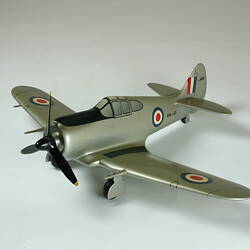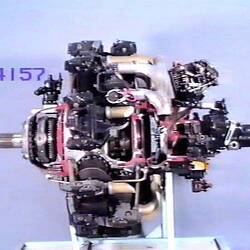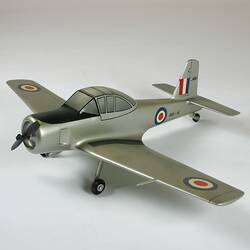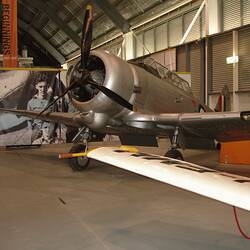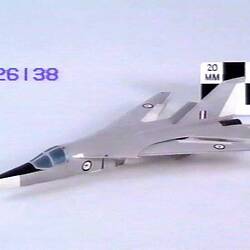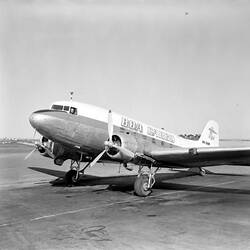Summary
Aircraft History
The Boomerang is a remarkable example of Australian adaption and innovation in response to a crisis. In December 1941, the outbreak war with Japan exposed an almost total lack of modern fighter aircraft for the Royal Australian Air Force (RAAF). In response, on 10 December 1941, the Commonwealth Aircraft Corporation (CAC) at Port Melbourne revived earlier proposals to build a 'Wirraway Interceptor' using components of the CAC Wirraway two-seat trainer in production since 1939 and the Pratt & Whitney R-1830 Twin Wasp engine being licence-built by CAC at Lidcombe, NSW for the Australian-built Beaufort bomber project. CAC design engineer Fred David produced the design concept drawings. David was a German Jew who had fled Nazi Germany after working for Heinkel AG and had spent a period in Japan working for Aichi Tokei Denko KK on the D3A dive bomber. The first Boomerang (as the aircraft was now known) was flown at CAC's Fisherman's Bend airfield on 29 May 1942. Drawing board to first flight had taken just five months.
After a period of operational evaluation by the RAAF at Laverton and at 2 OTU(Operational Training Unit) at Mildura in 1942, the Boomerang entered operational service in 1943. It was used in defence of Northern Australia and in New Guinea and Bougainville as an army co-operation aircraft where it proved to be well suited to the hazardous task of marking targets in mountainous terrain. Despite several attempts, no Japanese aircraft were shot down by a RAAF pilot flying a Boomerang. The importation of Curtiss P-40 Kittyhawk and Supermarine Spitfire fighters for the RAAF made the Boomerang obsolete for interceptor fighter duties. It remained in production until 1944, largely to keep the CAC factory occupied until production of Mustang fighters began. A one-off CA-14 prototype with a turbocharged engine was built along with 249 production aircraft in batches designated CA-12, CA-13 and CA-19. The Boomerang was quickly withdrawn from RAAF service in 1945 and many surviving aircraft were scrapped at Oakey in Queensland. One Boomerang is in the collection of the RAAF Museum and others in private hands are being restored to fly.
Model History
Model of a "Boomerang" fighter aircraft, as built by the Commonwealth Aircraft Corporation, Fishermen's Bend, Victoria, 1942-1944. Scale: 1:5 Full-size specifications: single-engined low-wing monoplane fighter with retractable main wheel gear. All-metal semi-monocoque wing, fabric-covered fuselage over tubular steel frame with wooden fairings. Length: 7.77 m; wingspan: 10.97 m; height: 3.96 m; max weight: 3492 kg; max speed: 265 knots Service ceiling: 10,360 m; Engine: Pratt & Whitney R-1830 "Twin Wasp" 1200 h.p. air-cooled 14-cylinder radial, built by Commonwealth Aircraft Corporation, Lidcombe, N.S.W.; 3-blade variable pitch propeller; armament: two 20 mm cannon; four .303 mm machine guns; 454 kg bombs. Hand-built by donor as a radio remote-controlled flyable model depicting the "Millingimbi Ghost", A46-206 which served with 83 Squadron RAAF. Model powered by "Tartan" 20 cc single-cylinder engine.
More Information
-
Collecting Areas
-
Acquisition Information
Loan & Subsequent Cultural Gifts Donation from Dr Wayne Fitzgerald, 05 Feb 2001
-
Acknowledgement
Donated through the Australian Government's Cultural Gifts Program.
-
Designer
Mr Friedrich David, Fishermans Bend (Fishermen's Bend), Greater Melbourne, Victoria, Australia, 1942
Chief Design Engineer for Original Aircraft Depicted. -
Modelmaker
Dr Wayne Fitzgerald, Melbourne, Greater Melbourne, Victoria, Australia, 1993-1995
-
Manufacturer of Item Modelled
Commonwealth Aircraft Corporation, Fishermans Bend (Fishermen's Bend), Greater Melbourne, Victoria, Australia, 1943-1945
Manufacturer of Original Aircraft. -
User of Item Modelled
Royal Australian Air Force (RAAF), Gove, Milingimbi, Northern Territory, Australia, 1944-1945
User of Original Aircraft Depicted. -
Classification
Air transport, Aircraft, Model propeller aircraft - military
-
Category
-
Discipline
-
Type of item
-
Overall Dimensions
1650 mm (Length), 2200 mm (Width), 520 mm (Height), 9 kg (Weight)
WEIGHT APPROXIMATE ONLY. WIDTH GIVEN ABOVE IS WINGSPAN OVER MAIN WINGS. WIDTH OVER TAILPLANE WITH MAIN WINGS REMOVED FROM FUSELAGE IS 82 cm.
-
Other Dimensions
1650 mm (Length), 820 mm (Width), 520 mm (Height)
The dimension is for the fuselage and tailplane. WEIGHT APPROXIMATE ONLY. WIDTH GIVEN ABOVE IS WINGSPAN OVER MAIN WINGS. WIDTH OVER TAILPLANE WITH MAIN WINGS REMOVED FROM FUSELAGE IS 82 cm.
-
Model Scale
1:5
-
Keywords
Fighters, Military Aircraft, Model Aeroplanes, Scale Models, Wars & Conflicts, Innovation & Design
